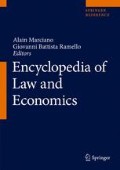Abstract
Concomitantly with the no-fault divorce revolution in the United States, there has been an increase in the divorce rate. From this observation, the question emerged of whether divorce law had a neutral effect on divorce behavior. Economists have conceptualized the issue by using an approach based on the “Coaseian” negotiation process, comparing unilateral divorce to divorce by mutual consent. The theoretical model predicts the neutrality of the law. But in the case of divorce, these assumptions are questionable. A determination as to the neutrality or non-neutrality of divorce law can thus be made based on empirical analysis. Early empirical studies came to conclusions favoring neutrality, but little by little, as methodological controversies accumulated, those empirical conclusions became more refined. Finally, a certain consensus emerged that the revolution in divorce would seem to have had a positive short-term impact on the divorce rate on the one hand, due more to the transition to unilateralism than to the abandonment of any reference to fault, and to have had a negative effect on the longer-term divorce rate on the other, because divorce law reform would seem to have prompted better-quality marriages.
Access this chapter
Tax calculation will be finalised at checkout
Purchases are for personal use only
References
Allen DW (1992) Marriage and divorce: comment. Am Econ Rev 82(3):679–685
Bracke S, Mulier K (2017) Making divorce easier: the role of no-fault and unilateral revisited. Eur J Law Econ 43(2):239–254
Brinig M, Buckley FH (1998) No-fault laws and at-fault people. Int Rev Law Econ 18(3):325–340
Drewianka S (2008) Divorce law and family formation. J Popul Econ 21:485–503
Ellman IM, Lohr SL (1998) Dissolving the relationship between divorce laws and divorce rates. Int Rev Law Econ 18(3):341–359
Friedberg L (1998) Did unilateral divorce raise divorce rates? Evidence from panel data. Am Econ Rev 88(4):608–627
Glenn ND (1997) A reconsideration of the effect of no-fault divorce on divorce rates. J Marriage Fam 59(4):1023–1025
Glenn ND (1999) Further discussion of the effects of no-fault divorce on divorce rates. J Marriage Fam 61(3):800–802
Gonzalez L, Viitanen TK (2009) The effect of divorce laws on divorce rates in Europe. Eur Econ Rev 53(2):127–138
Gruber J (2004) Is making divorce easier bad for children? The long-run implications of unilateral divorce. J Labor Econ 22(4):799–833
Kneip T, Bauer G (2009) Did unilateral divorce laws raise divorce rates in Western Europe? J Marriage Fam 71:592–607
Leeson PT, Pierson J (2017) Economic origins of no-fault divorce revolution. Eur J Law Econ 43(3):419–439
Mechoulan S (2006) Divorce laws and the structure of the American family. J Leg Stud 35:143–174
Nakonezny PA, Schull RD, Rodgers JL (1995) The effect of no-fault divorce law on the divorce rate across the 50 states and its relation to income, education, and religiosity. J Marriage Fam 57(2):477–788
Peters EH (1986) Marriage and divorce: informational constraints and private contracting. Am Econ Rev 76(3):437–448
Peters EH (1992) Marriage and divorce, reply. Am Econ Rev 82(3):687–693
Peterson R (1996) A re-evaluation of the economic consequences of divorce. Am Sociol Rev 61(3):528–536
Rasul I (2005) Marriage markets and divorce laws. J Law Econ Org 22(1):30–69
Rodgers JL, Nakonezny PA, Schull RD (1997) The effect of no-fault divorce legislation: a response to a reconsideration. J Marriage Fam 59(4):1026–1030
Rodgers JL, Nakonezny PA, Schull RD (1999) Did no-fault divorce legislation matter? Definitely yes and sometimes no. J Marriage Fam 61(3):803–809
Weitzman LJ (1985) The divorce revolution: the unexpected social and economic consequences for women and children in America. The Free Press, New York
Wolfers J (2006) Did unilateral divorce raise divorce rates? A reconciliation and new results. Am Econ Rev 96(5):1802–1820
Zelder M (1993a) The economic analysis of the effect of no-fault divorce law on the divorce rate. Harv J Law Public Policy 16(1):240–268
Zelder M (1993b) Inefficient dissolution as a consequence of public goods: the case of non-fault divorce. J Leg Stud 22:503–520
Author information
Authors and Affiliations
Corresponding author
Editor information
Editors and Affiliations
Rights and permissions
Copyright information
© 2019 Springer Science+Business Media, LLC, part of Springer Nature
About this entry
Cite this entry
Jeandidier, B. (2019). No-Fault Revolution and Divorce Rate. In: Marciano, A., Ramello, G.B. (eds) Encyclopedia of Law and Economics. Springer, New York, NY. https://doi.org/10.1007/978-1-4614-7753-2_678
Download citation
DOI: https://doi.org/10.1007/978-1-4614-7753-2_678
Published:
Publisher Name: Springer, New York, NY
Print ISBN: 978-1-4614-7752-5
Online ISBN: 978-1-4614-7753-2
eBook Packages: Economics and FinanceReference Module Humanities and Social SciencesReference Module Business, Economics and Social Sciences

